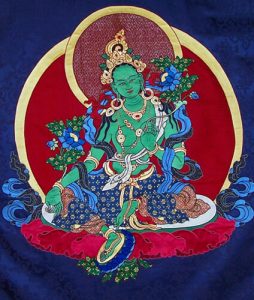
Tsoknyi Nepal Nuns (TNN) is one of many projects initiated by the revered Nepalese Tibetan Buddhist teacher Venerable Tsoknyi Rinpoche III, a tulku (incarnate lama) in the Drukpa Kagyu and Nyingma traditions of Vajryayana Buddhism and holder of the Ratna Lingpa and Tsoknyi lineages. Tsoknyi Rinpoche has been teaching in both the East and the West for more than 20 years and during that time has established many initiatives, including sacred text preservation, monasteries, nunneries, and Dharma centers, to name but a few.
When Julie Green, an American student of his since 2003, volunteered for one of these many projects, she expected to be asked to help raise funds to buy land for a retreat being developed in Crestone, Colorado by Tsoknyi Rinpoche’s Pundarika Foundation, whose primary mission is to support Rinpoche’s teaching activities and humanitarian work. Instead, Rinpoche told Julie about 3,000 Tibetan Buddhist nuns in Nangchen, Tibet for whom he had recently taken responsibility and whose traditional way of life was being eroded because of policies of the Chinese government. In 2005, Julie traveled with a small group of Western women to Nangchen to film a documentary about the Tsoknyi Lineage nuns in a remote area of the traditional Tibetan region of Kham. This film, Blessing, Journey to Nangchen, was released late in 2006. Julie then helped with fundraising for several years to create an endowment fund for a non-profit organization set up to support the nuns, before taking a break until 2011, when a series of life-changing events compelled her to resume her involvement.
In 2011, Tsoknyi Rinpoche organized a pilgrimage to Nepal, India, and Bhutan. Rinpoche had undertaken several of these pilgrimages before, but Julie had never been very interested. “I wasn’t sure I wanted to travel with over 100 people on various tour buses. I procrastinated until the very last minute and was the last person to sign up,” she recalls, noting that in 2011 she somehow “felt pulled to go.”
A few months before signing up for the pilgrimage, Julie had received a desperate email from an American friend who had been living in Nepal on retreat, begging for help with a newly established nunnery called Chobar Monastery. Confused, Julie slowly pieced together the full story: in 2010 Tsoknyi Rinpoche had handed over control of the large Tergar Osel Ling Monastery in Kathmandu to his brother, the revered teacher Yongey Mingyur Rinpoche, in order to focus his attention on the old, abandoned Chobar Monastery on Chobar Hill just outside of Kathmandu.
“Chobar Monastery was designed to house 35 monks,” says Julie. “Tsoknyi Rinpoche wanted to devote his efforts to female monastics and so gave Osel Ling to his brother. When Tsoknyi Rinpoche took possession of Chobar, dozens of his nuns who had escaped Tibet [to Nepal] moved in immediately and began cleaning and making it their home.”
“Later in 2010, both Mingyur Rinpoche and Tsoknyi Rinpoche traveled to their childhood village high in the Himalayas in the Nubri region of Nepal,” she explains. “Tsoknyi Rinpoche noticed that there were no girls attending the local school sponsored by the brothers. The parents explained that they wanted a more traditional education for their girls and Rinpoche mentioned that perhaps a few could come to the newly founded Chobar Nunnery. In the spring of 2011, 82 young girls aged 5–14 showed up! They were dressed in rags, malnourished, and scared; thus the cry for help from my friend. She said they had nothing for these girls—no money, teachers, or educational supplies.”
When Julie arrived in Kathmandu in October 2011, she went to Chobar to assess the situation along with Jean Chang, an American who had been involved with Rinpoche’s organizations in the US since Rinpoche began teaching there 22 years ago. Immediately upon arrival they knew that Rinpoche needed help with all of these little girls and nuns as the population of the tiny monastery had grown to 120 people. Together they made a proposal to Rinpoche to create TNN, which would help support and educate these young girls and female monastics.
Rinpoche was already aware that more housing was needed, so Julie and Jean returned to the US to set up the non-profit organization, assuming that “it would mostly be about fundraising for general support and educational supplies.” They agreed to return to the nunnery in February 2012 and when they did, they arrived to find a full site plan with six new buildings and Rinpoche’s vision of creating a nine-year shedra (monastic college) and residence for the nuns, a secular primary school to be certified by the government of Nepal, an international meditation center, a kitchen and dining hall, a large shrine hall, as well as a building for three-year retreats that was already going to be sponsored by the Pema Chödrön Foundation. As Julie recalls, “Jean and I took a deep breath, said okay, and began planning the fundraising to build Tsoknyi Gechak Ling Nunnery and Educational Center.”
According to the Buddha’s teachings, monastics are totally dependent on the laity for the four requisites: food, medicine, living place, and clothes, because they do not produce any of these themselves. It is therefore considered extremely meritorious among lay Buddhists to offer these necessities to monastics. Indeed, it is a great honor to serve and preserve the Buddha, the Dharma, and the sangha in Nepal, the birthplace of Shakyamuni Buddha himself, and few Americans have been given such an auspicious opportunity. Julie Green is now the executive director and treasurer of TNN, while Rinpoche is the president of the organization. Other board members include Jean Chang, vice-president, and Michael Kunkel, who serves as secretary.

What’s behind Julie’s untiring drive to support Buddhist nuns? “Helping women is where my passion lies”, she says, noting that the opportunity to be of service to her teacher in his native land was also a gift to her practice. The project is also an opportunity to support her teacher’s efforts in educating and uplifting the nuns of his lineage.
Julie feels that some of the biases against women in the Tibetan Buddhist tradition have been eroded in recent years. “It’s starting to break apart,” she says. “The ultimate goal is for the nuns to be female teachers and to spread out around the world to teach the Dharma in the female form.” She adds that Rinpoche and other progressive monastics have been setting an example that has started a shift in the Buddhist world to erase the myth that enlightenment cannot be attained in the female form.
Has there been any feedback from the organization’s volunteers who have had the chance to visit the nunnery? “I think that’s another one of the rewards, going to visit the nunnery,” affirms Julie. “The nuns are always practicing pujas, every day; they see the nuns receiving teachings and them being so uplifted, it’s kind of magical almost. Devotion is omnipresent; if you ever want to have your mind be empty, that will do it. And just to be able to practice with women, anyone visiting experiences this as a volunteer, this human quality that comes through. You can’t come away from the place without feeling good in your heart.”
Julie is equally enthusiastic on the success of fundraising and building efforts so far: “When I became involved in 2004, I knew I would be doing this for the rest of my life, and I have so much respect for Rinpoche. It’s so much bigger then what we initially imagined. What’s going on with Tibetan Buddhism in Nepal is amazing! I shake my head in constant awe.”
Temple construction began in 2011 and, despite a delay resulting from the devastating earthquakes that hit Nepal in 2015, consecration is set for Losar, the Tibetan New Year, 2018. Through an active social media campaign and films about the initiative being produced and shared, supporters not only in the US but around the world can be constantly updated and inspired by the fundraising. Rinpoche’s sister organizations are also helping to spread the word through their own social media.
Julie sees a bridge being built through her work in Colorado, across oceans and continents, to her teacher’s homeland of Nepal. In this way an international sisterhood has been formed, which has become a critical part of her practice. “Many people have said ‘this is your practice.’ It’s such an important part of my life, I will never, ever let these girls down. It deepens my practice; it feels like my practice is in action, and it suits me to be building things and creating things. It feels it was meant to be a part of my life,” says Julie. “They are our sisters, we are really connected—we are chanting the same chants. The bridge is wonderful. It’s important for Westerners to realize how people live in other parts of the world and that women do need help to be lifted up.”
See more











